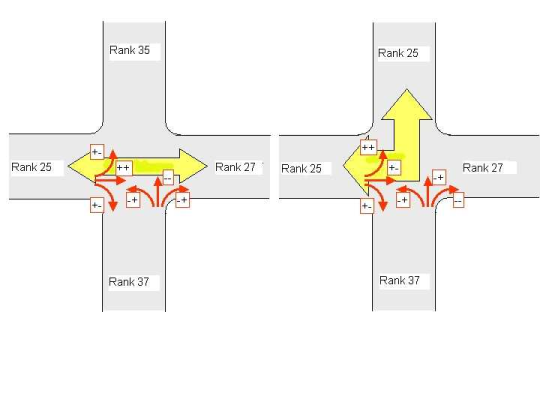Visum describes the traffic-related properties of links with link attributes. It also offers the possibility of dividing links with the same properties into link types, which in turn have attributes. Each link belongs to a link type via its attribute Type number. The link types serve as network classifiers and make it possible to assign type-specific default values for the following link attributes.
- List of permitted transport systems on a link
- Capacity PrT
- Permitted free flow PrT speed (v0 PrT)
- Minimum speed
- Number of lanes
- Rank of identification of the link rating
- Permitted maximum speed vMax-TSys of every PrT transport system
- Transport system-specific speed in PrT for toll
- Transport system-specific speed v-PuTSys for the calculation of transport system-specific PuT run times t-PuT from the link lengths
- Three cost rates per transport system in PuT for the calculation of link costs within the operator model (Calculation of the operating costs)
Basically, the values of attributes of the same name of a link are independent of those of the assigned link type. This means that you can attribute each link independently of the link type. However, it is recommended to apply exactly those values of the link type in the link. This is how you will achieve as consistent as possible modeling of links and modifications to attributes can be made more easily, because you can change these in the link type and then apply these to the links (User Manual: Specifying link types).
For the assignment, each link type can be assigned a capacity restraint function, which thus applies for all links of this link type (Impedance and VD functions). This allows you to apply a different mathematical correlation for the calculation of impedance on non built up rural roads and built up urban roads.
Major flows
From the rank of the link types of the link which flow into a node, Visum determines a flow hierarchy with a major flow. This always refers to two different link orientations (Network objects of the junction model). The major flow is taken from one of the three criteria (Turn standards) to determine the time penalties for the exiting turning processes from the major flow or from another link. It should therefore, if possible, correspond to the movement that has the right of way or is particularly favored by the signal controller. With this the rank of the link types indirectly influences the result of the PrT assignment. The Image 6 shows an example of determining the flow hierarchy and particularly the major flows.

Image 6: Rank of the link type and its resulting major flows (yellow), flow hierarchy (red)
|
Note: In the PuT model, the rank has no influence on the assignment result. |

